Breaking Down PRINCE2: Core Elements and How They Fit Together
 Annie Lee
Annie Lee
No matter the project – a product launch, system upgrade, or process change, teams need clarity, shared roles, and a reliable way to stay on track. That’s where PRINCE2 comes in. Widely adopted across industries, it offers a structured yet flexible framework to manage projects with confidence.
At first, PRINCE2 may seem complex. But behind the formal terms and defined roles lies a practical approach: focus on outcomes, manage risk, align with business goals, and learn as you go.
In this guide, we’ll break down PRINCE2’s core elements: Principles, themes, processes, and tailoring, and show how they work together across the project lifecycle to support clear, consistent, and adaptable project delivery.
What is PRINCE2?
PRINCE2 stands for Projects IN Controlled Environments. It’s a process-based project management method developed by the UK government and now used worldwide across industries. What makes it popular is its adaptability and clarity—it tells you what needs to happen, when, and who is responsible.
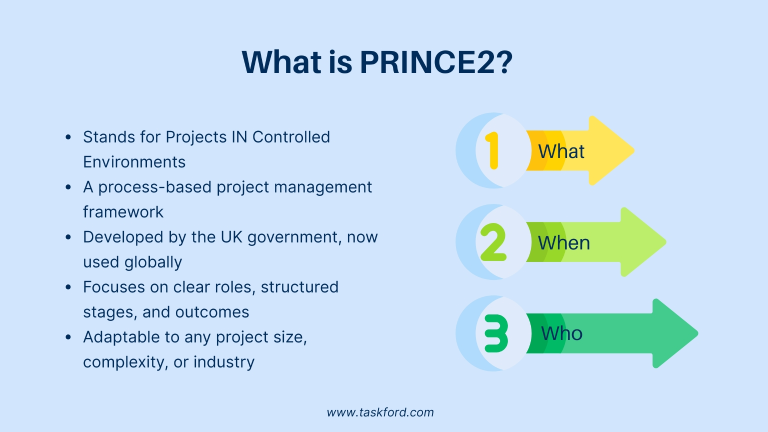
Unlike some methodologies that dictate detailed practices, PRINCE2 is more of a framework. It provides guiding structure and principles, but allows you to tailor it to your project's size, complexity, and context.
So, whether you’re working in IT, operations, marketing, or construction, PRINCE2 helps align everyone involved through a common language and process.
Benefits of PRINCE2 project management
PRINCE2 is known for being practical, scalable, and adaptable. Its benefits are especially clear in complex environments where coordination, control, and communication are essential.
1. Clear Roles and Responsibilities
PRINCE2 defines clear project roles from the outset—who makes decisions, who delivers work, and who provides oversight. This reduces ambiguity and improves accountability across teams.
2. Strong Business Alignment
PRINCE2 places the business case at the center of the project. Every stage must justify its value, ensuring the project stays aligned with strategic goals.
3. Risk and Change Management
Risk isn’t treated as a side note. It’s actively managed throughout the project lifecycle, helping teams avoid surprises and make informed decisions.
4. Controlled Delivery in Stages
By breaking projects into manageable stages, PRINCE2 allows teams to review progress, learn from each phase, and make informed go/no-go decisions along the way.
5. Tailored to Context
Whether your team is large or small, experienced or new, PRINCE2 can be adapted to fit your way of working.
The Core Elements of PRINCE2
PRINCE2 is built on four core elements that work together to provide structure and flexibility:
Principles – The foundation of the method
Themes – Key project areas to manage throughout
Processes – The step-by-step workflow from start to finish
Tailoring – Adapting PRINCE2 to suit your environment
Let’s explore each of these in detail.
The 7 Principles of PRINCE2
Continued Business Justification – The project must consistently deliver value and remain aligned with business objectives. If the justification no longer holds, the project should be reassessed or stopped.
Learn from Experience – Lessons from previous projects should be captured and applied throughout the project to inform decisions and avoid repeating mistakes.
Defined Roles and Responsibilities – Everyone involved should have a clear understanding of their role, responsibilities, and how they interact with others within the project team.
Manage by Stages – Projects are broken into defined stages, each with its own planning, monitoring, and control, allowing better oversight and decision-making.
Manage by Exception – Projects are managed within pre-set tolerances for time, cost, and scope. Only deviations require escalation, reducing micro-management and increasing team autonomy.
Focus on Products – Projects are centered around well-defined deliverables. Outputs are specified early to guide planning and ensure alignment with expectations.
Tailor to Suit the Project – The PRINCE2 framework must be adapted to suit the project’s scale, complexity, environment, and team structure.
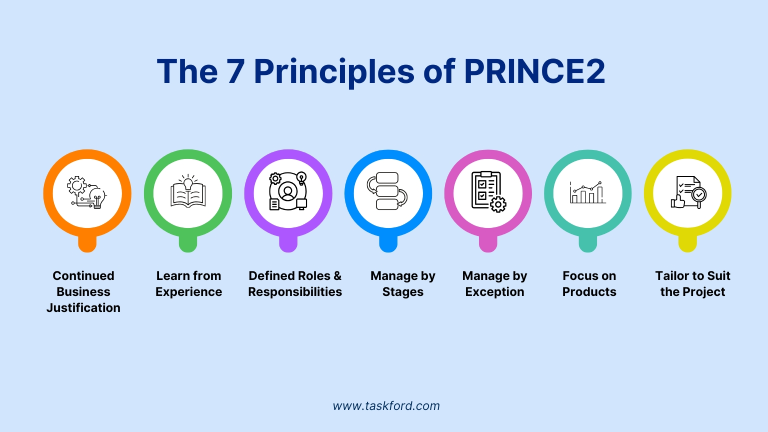
The 7 Themes of PRINCE2
Themes represent areas of project management that require ongoing attention. They work alongside the principles and are applied throughout each process.
Business Case – Ensures the project remains desirable, viable, and achievable throughout its lifecycle.
Organization – Defines the project team structure and clearly outlines roles and responsibilities.
Quality – Describes what needs to be delivered and how to ensure that deliverables meet agreed standards.
Plans – Explains how and when project objectives will be achieved, including timeframes, resources, and key milestones.
Risk – Identifies, evaluates, and manages potential threats or opportunities that could affect project outcomes.
Change – Provides a structured approach for handling change requests or unexpected shifts in project scope.
Progress – Tracks and compares actual performance against plans, helping keep the project under control.
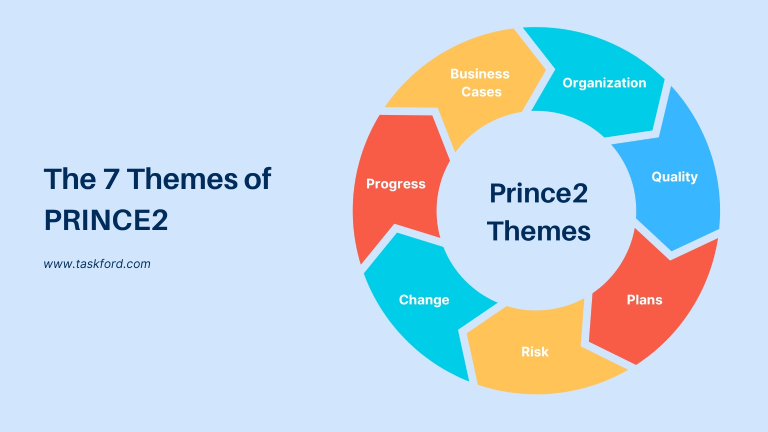
The 7 Processes of PRINCE2
Processes guide the flow of work across the project lifecycle, from starting a project to closing it. Each process has defined inputs, outputs, and responsibilities.
Starting Up a Project (SU) – Confirms whether the project is viable before significant resources are committed. A project brief and an outline business case are created.
Directing a Project (DP) – Provides strategic direction and decision-making. The project board oversees progress and approves major decisions.
Initiating a Project (IP) – Establishes the detailed plans, risk strategy, quality expectations, and controls that will govern delivery.
Controlling a Stage (CS) – Manages daily work, including progress tracking, issue resolution, and reporting within agreed tolerances.
Managing Product Delivery (MP) – Focuses on delivering specific outputs. Teams accept work packages, complete them, and return deliverables to the project manager.
Managing a Stage Boundary (SB) – Reviews the performance of the current stage and plans for the next, ensuring continued business justification.
Closing a Project (CP) – Wraps up all activities, confirms deliverables have been accepted, documents lessons learned, and formally closes the project.
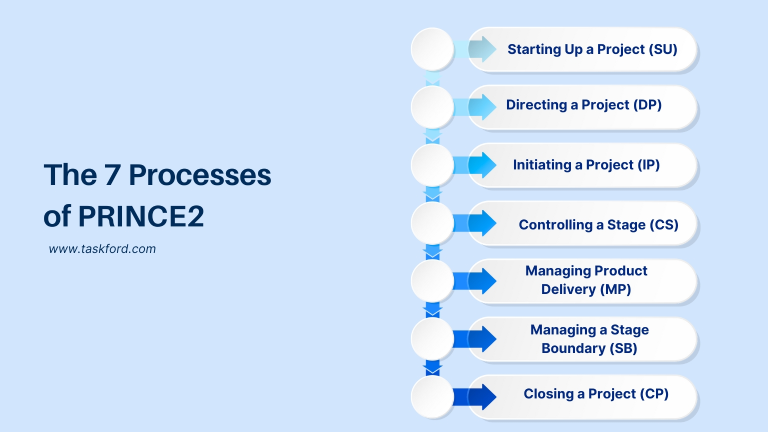
How the Core Elements Fit Together
PRINCE2’s strength lies in how its elements—principles, themes, processes, and tailoring work together as a complete system. Each plays a distinct role but is designed to support and reinforce the others throughout the project lifecycle.
Principles – Provide the foundational mindset and guidance for how the project should be managed. They influence every decision and action taken across the project.
Themes – Represent key areas of project management, like risk, quality, and planning, that must be monitored and maintained throughout the project. Each theme connects directly back to one or more principles.
Processes – Define the sequence of activities required to manage a project from start to finish. They bring the principles and themes into action through structured workflows, decision points, and role-based responsibilities.
Tailoring – Ensures that all aspects of PRINCE2 are adapted to the project’s specific context, its size, complexity, and environment, without losing the integrity of the framework.
Together, these elements create a cohesive and adaptable approach.
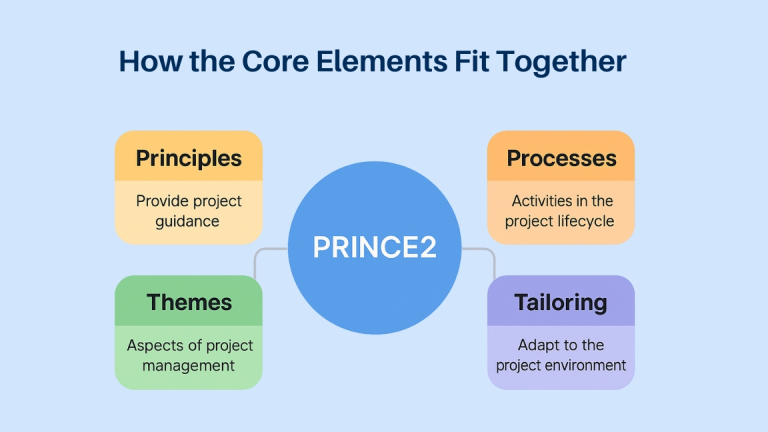
For example, the principle of “Focus on Products” is supported by the Quality theme and implemented through the Managing Product Delivery process. Similarly, the Manage by Exception principle works hand-in-hand with the Progress theme, enabling governance without micro-management.
By aligning these elements, teams are able to maintain control, adapt to change, and stay focused on delivering value, no matter the size or type of project.
Common Challenges and Misunderstandings
While PRINCE2 offers a well-structured and flexible framework, it’s not uncommon for teams to misapply or misinterpret parts of it, especially when first getting started. Here are some common pitfalls to be aware of:
Treating PRINCE2 as overly rigid – The method is often seen as bureaucratic or documentation-heavy. In reality, one of its core principles is tailoring, which encourages teams to adapt the framework to their own project context.
Overemphasizing templates over thinking – PRINCE2 provides structure, but not at the cost of judgment. It's easy to fall into the trap of filling out forms without using them to drive meaningful discussion or decision-making.
Neglecting the business case – Sometimes, teams create a business case at the beginning but fail to revisit it. PRINCE2 requires that it be actively maintained throughout the project to ensure ongoing alignment with business goals.
Unclear roles and responsibilities – Without clearly defined project roles, projects can quickly lose direction. PRINCE2 is built to prevent this—but only if roles are communicated and understood across the team.
Skipping lessons learned – The principle of learning from experience is often overlooked. If teams don’t document what worked and what didn’t, the same mistakes are likely to happen again.
Avoiding these challenges means embracing the intent of PRINCE2, not just its structure. It's about managing with purpose, not following rules for their own sake.
Applying PRINCE2 in Practice
Putting PRINCE2 into practice doesn’t mean applying every detail from day one. Start small, stay practical, and build up based on what adds value to your project environment.
- Start with the Principles
Use the seven principles as your foundation. They offer a mindset that encourages value-driven delivery, accountability, and learning.
- Tailor It to Fit
Don’t apply PRINCE2 rigidly. For smaller projects, simplify documentation and combine roles where possible. For more complex work, scale up the structure and governance. Always adapt to the needs of the project.
- Clarify Roles Early
Clearly define who’s responsible for what. Whether you're using formal titles or adapting roles to fit your team, clarity around ownership is key to avoiding bottlenecks and confusion.
- Plan and Deliver in Stages
Break your project into manageable stages with clear checkpoints. This improves control, visibility, and the ability to adjust plans before risks escalate.
- Keep the Business Case Alive
Revisit the business case at the end of each stage. This ensures the project is still worth pursuing and remains aligned with your organization’s goals.
- Use Themes as Ongoing Checks
The themes (like Risk, Quality, and Change) aren’t just setup items—they should guide decision-making throughout. Treat them as regular checkpoints, not one-time tasks.
- Support with Tools
Using tools like TaskFord can help teams implement PRINCE2 more easily by embedding structure, tracking progress, assigning roles, and managing documents—all without slowing things down.
- Grow With It
Start with the basics. Apply what’s needed now, and expand as your team becomes more confident. PRINCE2 is meant to scale with you, not overwhelm you.
Conclusion
PRINCE2 continues to be one of the most effective and adaptable frameworks for managing projects across industries. By combining structure with flexibility, it helps teams stay focused on value, make informed decisions, and deliver results with confidence.
Understanding how the core elements—principles, themes, processes, and tailoring—fit together makes the framework easier to apply in practice. It’s not about ticking boxes; it’s about creating clarity, control, and collaboration across the entire project lifecycle.
Whether you're managing a small internal initiative or a large, cross-functional program, PRINCE2 gives your team a shared language and a reliable approach to move from planning to delivery successfully and sustainably.
Related Resources
Project Management Terms - From Agile to WBS: 80 Key Terms You Should Know.
What is Program Management How It Goes Beyond Project Management.
What is Project Management - The Completed Guide for Beginners.
Top Free Gantt Chart Software - Expert Reviews.
Subscribe to my newsletter
Read articles from Annie Lee directly inside your inbox. Subscribe to the newsletter, and don't miss out.
Written by

Annie Lee
Annie Lee
Product Marketing Manager who’s genuinely curious about how teams get things done, especially when it comes to project management, resource planning, and agile workflows. I love turning complex processes into clear, actionable strategies that help teams move faster without losing focus. At TaskFord, I work closely with product and operations to bridge the gap between strategy and execution. Here, I share lessons learned, real-world frameworks, and ideas to help teams work smarter—no fluff, just practical takeaways.